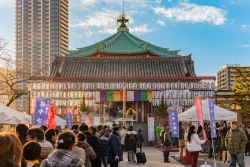
July 23, 2009
Closed Gates
The Japanese government is often criticized for its treatment of refugees - But a look behind the numbers reveals that the situation is more complex than it seems
By Metropolis
Originally published on metropolis.co.jp on July 2009
 It’s easy not to notice them: they blend in anonymously with the rest of the foreign faces here. You could be forgiven for not even realizing they exist at all. But refugees and asylum seekers are very much a reality in Japan—and as their numbers increase, the government is coming under fire for its handling of the issue.
It’s easy not to notice them: they blend in anonymously with the rest of the foreign faces here. You could be forgiven for not even realizing they exist at all. But refugees and asylum seekers are very much a reality in Japan—and as their numbers increase, the government is coming under fire for its handling of the issue.
Despite being the third largest donor in the world to the United Nations High Commissioner for Refugees (UNHCR), Japan admits only a tiny number of asylum seekers compared to other industrialized nations, and often appears reluctant to grant refugee status to those who do come. Damning statistics are bandied about, such as the fact that the country has accepted just 508 refugees from the 7,297 applications made since 1982.
The media doesn’t paint a very flattering picture, either. Many will remember the Dogan and Kazankiran families, Kurdish Turks whose unsuccessful battle to be recognized as refugees in Japan was reported extensively in local English-language press and overseas. When two members of the Kazankiran family were summarily deported in January 2005, the UNHCR denounced the move as “against international law,” and the Japanese government received widespread condemnation.
Both families have since been resettled in other countries, but the memory of their struggle has lingered on. So too have criticisms from organizations such as Amnesty International, which reported in May that Japan “continued to deport failed asylum applicants to countries where they faced a risk of torture or other ill-treatment.” Not exactly the most glowing of report cards. But is the reality as bad as the detractors would have us believe?
Japan has only recently begun to feel the impact of the refugee crisis. It didn’t ratify the 1951 UN Convention relating to the Status of Refugees until 1981, bowing to international pressure in the wake of the Vietnam War and the flow of refugees—the so-called “boat people”—that resulted from it. It took three years after the fall of Saigon for Japan to accept just 500 people, and ten years before the quota was raised to 11,500. Although these were significant numbers for a country that had never previously taken in refugees, the government wasn’t ready to open the floodgates yet. Instead of granting individual refugee status to those it accepted, Japan admitted the refugees as a group based on humanitarian grounds. The number of refugees accepted thereafter slowed to a trickle—during the whole of the 1990s, fewer than 50 asylum seekers were granted refugee status.
Refugees, by definition, are people fleeing persecution or danger in their home country to seek safety and a better life elsewhere. Nations which have signed the UN Convention on Refugees, including Japan, pledge to protect them. Yet those who arrive here as asylum seekers are routinely treated as illegal immigrants and incarcerated in detention centers. Legal advice is difficult to obtain, and those who manage to apply for refugee status are faced with an average wait of two years to get an answer.







